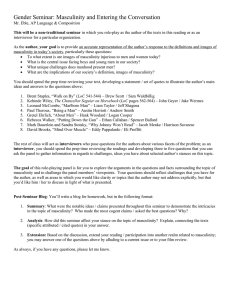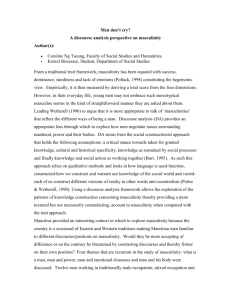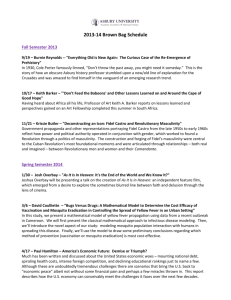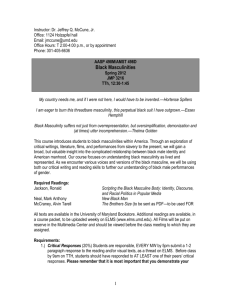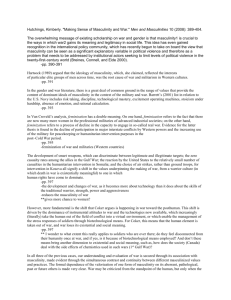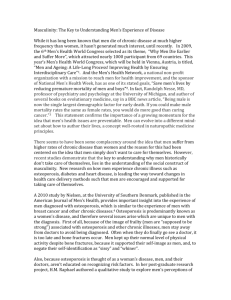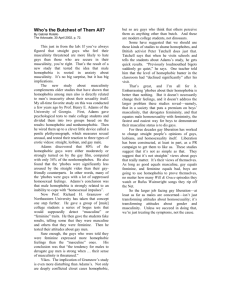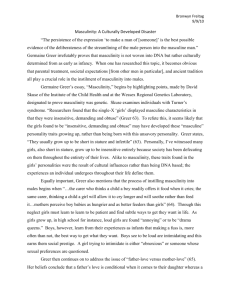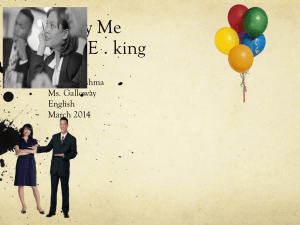Masculine Theory
advertisement
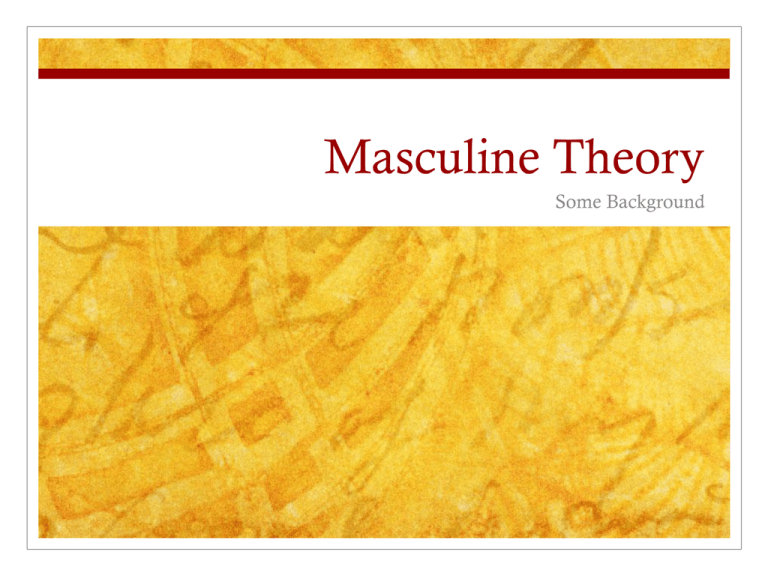
Masculine Theory Some Background From Fighting Ruben Wolfe Miffy: “Miffy, for God’s sake. What a name. He’s a Pomeranian and he’s a dead-set embarassment to walk. So we wait until it gets dark…the fluffy embarrassment machine comes prancing towards us like a damned ballerina. I promise you when we’re walking that dog and see someone we know, we pull our hoods over our heads and look the other way…..” (Zuzak, 2000, p. 26) Why is this important? We believe schools should be sites of inquiry into forms of social difference (gender, race, ethnicity, etc.) with the goal of expanding human freedom and potential within the bounds of a democratic society (Bean & Harper, 2007). Challenging essentialized masculinity is important because: Acting outside these norms can result in name-calling, missing school due to psychosomatic illness, bullying, and suicide What is masculine theory? Like feminist theory, examines how gender is scripted in life and texts Key elements (from Blackburn & Smith, 2010; Dutro, 2003): Performative social practices (e.g. football) Who has power (e.g. high school jocks) Is relational (e.g. what it means to be: a girl, guy, gay, etc.) Disrupts hegemonic masculinity (power issues) Disrupts fixed sets of attributes that define masculinity Young Adult Novels Font shifts (often to cursive) signal safe spaces for jettisoning tough guy positioning, Cameron asks his brother prior to an illegal boxing match: “Are you scared, Rube?” “Yeah.” There’s no point lying. I’m scared as hell. Scared crazy. I’m asylum scared. Straightjacket scared. Yes, I think it’s pretty much decided. I’m scared” (p. 85) Steve in jail in Monster “The best time to cry is at night, when the lights are out and someone is being beaten up and screaming for help. That way even if you sniffle a little they won’t hear you. If anybody knows that you are crying, they’ll start talking about it and soon it will be your turn to get beat up” (Myers, 1999, p. 1) Research in Masculine Theory Directions: A transformative pedagogy aimed at opening up spaces for students to read against the grain of traditional masculinity Scholars: Wayne Martino, Michael Kehler, Hightower, Dutro, and others Using young adult novels and critical questions of character and reader positioning (see Bean & Harper, 2007 for a longer list of needed research) View masculinity as a topic “so that students could deconstruct and interrogate it as a way to accomplish the goals of social justice References Bean, T. W., & Harper, H. J. (2007). Reading men differently: Alternative portrayals of masculinity in contemporary young adult fiction. Reading Psychology, 28, (1), 11-30. Blackburn, M. V., & Smith, J. M. (2010). Moving beyond the inclusion of LGBT-themed literature in English Language Arts classrooms: Interrogating heteronormativity and exploring intersectionality. Journal of Adolescent & Adult Literacy, 53, (8), 625-634. Dutro, E. (2003). “Us boys like to read football and boy stuff.” Reading masculinities, performing boyhood. Journal of Literacy Research, 34, 465-500. Myers, W. D. (1999). Monster. New York: HarperCollins. Ruben Wolfe Zusak, M. (2000). Fighting Ruben Wolfe. NY: Scholastic.
